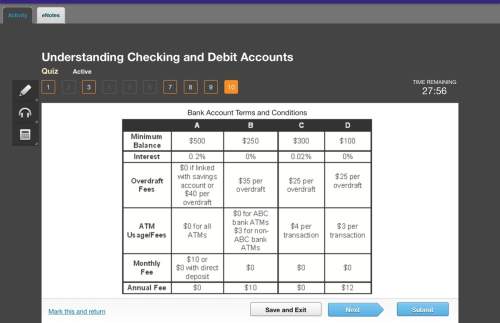
Business, 30.10.2021 01:50 triston12192000
Solar Innovations Corporation bought a machine at the beginning of the year at a cost of $22,000. Assume the estimated productive life was five years and the residual value was $2,000. The estimated productive life of the machine is 10,000 units. Expected annual production was year 1, 2,000 units; year 2, 3,000 units; year 3, 2,000 units; year 4, 2,000 units; and year 5, 1,000 units. Required: Complete a depreciation schedule for the units-of-production method. Prepare the journal entry to record Year 2 depreciation.

Answers: 1


Other questions on the subject: Business

Business, 21.06.2019 18:20, jrjordans13ox06qs
When someone buys a fourth television for his or her house, what is the result? a. there's a decrease in the marginal utility of the television. b. the increase in demand brings leads to higher prices for televisions. c. the production of televisions becomes more efficient. d. there's a rise in the opportunity cost of buying other goods.
Answers: 2

Business, 22.06.2019 19:50, crzyemo865
Aproduction line has three machines a, b, and c, with reliabilities of .96, .86, and .85, respectively. the machines are arranged so that if one breaks down, the others must shut down. engineers are weighing two alternative designs for increasing the line’s reliability. plan 1 involves adding an identical backup line, and plan 2 involves providing a backup for each machine. in either case, three machines (a, b, and c) would be used with reliabilities equal to the original three. a. compute overall system reliability under plan 1. (round your intermediate calculations and final answer to 4 decimal places.) reliability b. compute overall system reliability under plan 2. (round your intermediate calculations and final answer to 4 decimal places.) reliability c. which plan will provide the higher reliability? plan2plan1
Answers: 3

Business, 22.06.2019 20:20, laidbackkiddo412
Tl & co. is following a related-linked diversification strategy, and soar inc. is following a related-constrained diversification strategy. how do the two firms differ from each other? a. soar inc. generates 70 percent of its revenues from its primary business, while tl & co. generates only 10 percent of its revenues from its primary business. b. soar inc. pursues a backward diversification strategy, while tl & co. pursues a forward diversification strategy. c. tl & co. will share fewer common competencies and resources between its various businesses when compared to soar inc. d. tl & co. pursues a differentiation strategy, and soar inc. pursues a cost-leadership strategy, to gain a competitive advantage.
Answers: 3

Business, 22.06.2019 20:30, alyssanewsome
The research of robert siegler and eric jenkins on the development of the counting-on strategy is an example of design.
Answers: 3
You know the right answer?
Solar Innovations Corporation bought a machine at the beginning of the year at a cost of $22,000. As...
Questions in other subjects:





Social Studies, 04.01.2020 00:31


Social Studies, 04.01.2020 00:31


Mathematics, 04.01.2020 00:31

Social Studies, 04.01.2020 00:31




